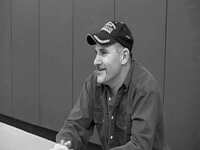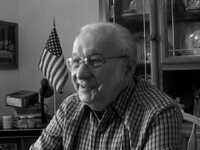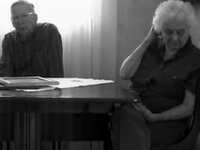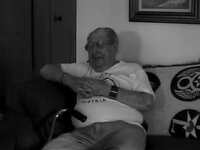Search
113 items
-
Douglas Brinker served in the United States Army as a truck driving during both Desert Storm and Operation Iraqi Freedom.
-
Charlie Brown entered the Service shortly after completing high school in Ann Arbor. He was working at the A&P at the time. After his Basic Training, he was sent overseas. It wasn't too long before he was involved in the Battle of the Bulge. There was a great deal of mud that the trucks that he worked with had to get through. Charlie and his group had to cut trees, so that the trucks could avoid it. There were no power saws, so everything was done by hand. At one point, Charlie was asked to drive one of the trucks, because the regular driver was not available. They hit a landmine and the truck was blown up. The two men next to him received shrapnel wounds. Three men in the back were blown out of the truck, and although they were bruised, they survived. Charlie received minor bruises. After taking a pounding from the Germans, his Colonel decided to surrender. The Colonel told the Unit that they had a choice. They could surrender to the Germans or try to find a way to escape. Charlie and a group of about 50 G.I. 's decided to try the latter. The 50 plus group spent a total of 4 days behind the German lines. During this time, the group tried to avoid detection. Charlie reported that one time he was so close to a German soldier who was looking for his buddy, that he could have tripped the German. Of course, he didn't. Another time, the exhausted group took a nap. One of the other soldiers woke Charlie, because they were in the middle of a German tank assembly area. For all 4 days, Charlie only had one candy bar to eat. When the group finally got back to the American lines, they all ate much better, but since they had not eaten for so long, the food did not stay with them. Charlie was still in Belgium when V-E Day was declared. Afterwards, they were packed up and prepared to go to the Pacific. Everyone was relieved when V-J Day was declared. He then started his trip home. While awaiting his discharge, Charlie was in Indiana, near enough to his relatives to visit. On one occasion he was taking a shortcut through a cemetery. There was an empty grave that he jumped into, to see how it felt. His cousin told him to get out. The gravestone was for CHARLE W. BROWN. He used the G.I. Bill to get an Associate’s Degree from Cleary College. He then went to work for the State of Michigan, and finally worked up to Assistant Business Manager at the local State Hospital. Charlie was married for 50 years before his wife died. His second wife was a widow after 40 years of marriage. They have been married for seven years. Charlie said that he has been married for 97 years.
-
Donald Brown volunteered for the draft, after one and a half years at Harvard. He was feeling guilty about being one of the few young men in upstate New York who was not serving. Shortly after entering military service, he was put into the ASTP program, and given a choice of which college he wanted to go to for his studies. He chose Indiana State, where he later met his wife. Eventually, he was assigned to a Medical Unit of the 20th Armored Division and was sent to Europe. After months of minor skirmishes, his unit took part in a major battle outside of Munich, where there were many casualties. On May 1, 1945, his unit was sent to Dachau near Munich, "before it was cleaned up for the Tourists." He never forgot what he saw there. After V-E Day, his unit was meant to be sent to the Pacific. On one of the train trips through France, he was told to go up to one of the front cars. He chose to stay with his unit, which turned out to be a lifesaving choice. The first four cars of the train were completely destroyed in a wreck. While on furlough, just prior to being sent to the Pacific, he got married, and soon afterwards, the Japanese surrendered. Donald spent 13 years teaching at Berkeley after having completed his studies. There, he was eventually fired because he refused to sign a loyalty agreement. He went to Bryn Mawr College, and in 1964, began teaching in the Psychology Department at the University of Michigan, where he retired in 1997. He currently lives in Ann Arbor, Michigan, and teaches a class on WWII at the University.
-
Bruce Bryan was born on May 20, 1920, in Metro, South Dakota. He always knew he wanted to be a pilot and joined the Air Corps in 1941. His basic training began immediately upon joining the service. At first, Bruce was too underweight to become a pilot, but within a few weeks he gained 14 pounds, making him eligible for pilot training. Three months after he joined the Air Corps, the Japanese bombed Pearl Harbor. For the first three years of the war, Bruce remained in the United States. When he was finally sent overseas, he began flying missions over Italy. One day, his plane took two direct hits and went down. He was quickly captured, and spent the next eight months in a POW camp in northern Germany. Although the Germans allowed him to write letters, his family never received these letters, and were told he was missing in action. Bruce states that for the most part, his treatment was acceptable. One guard did "knock him around" but that was not the treatment that he usually received. In April 1945, Russian troops liberated his camp. When VE Day arrived, he was turned over to U.S. forces. In May 1946, Bruce got married. He and his wife of over 60 years live in Allen Park, Michigan.
-
Joseph Butcko was born in Ypsilanti, and at the time that World War II broke out, he was apprenticed in the tool and die business. He was drafted into the armed forces at age 19. Joseph was already married at that time, to his high school sweetheart. Both of his brothers were also serving in the war, both in the Pacific Theater. He chose to enter the Navy and went to basic training at the Great Lakes institution, in Chicago, IL. Joseph traveled briefly to Norfolk, VA, and then was sent back to Chicago, to practice gunnery at Navy Pier. He was eventually shipped out to Guam, as a helmsman on a Landing Ship Tank (LST). There were over 100 men on his crew, and despite the fact that it was considered a big crew, he eventually got to know every soldier on it. While on Guam, he saw many soldiers returning from the battle of Iwo Jima in ambulances and taken to the hospital up the mountain - this experience really drove the reality of war home to him. Joseph took part in the attack on Okinawa, in which he drove a shuttle landing craft (a small craft) back and forth from larger boats, to carry marines to the beach. There were many Japanese Kamikaze planes involved in this battle, and he saw his brother's ship hit by two Kamikaze planes - luckily, no one was killed. While serving in the Pacific, Joseph ran into many friends from Ypsilanti, as well as both of his brothers. After the war was over, Joseph served in China, keeping the peace. He also helped facilitate the transportation of Japanese soldiers and civilians, who had been occupying much of China, back to Japan. When he was discharged from the Navy, he returned to Ypsilanti to work in the tool and die manufacturing business.
-
Mr. Campbell was born in Winnipeg, Manitoba, but was an American citizen moved to the United States when he was young. Wanting to join the conflict, Mr. Campbell crossed the Detroit River to enlist in the Canadian Royal Navy. Even though he was born in Canada and was a Canadian citizen, he was often referred to as a Yankee. The veteran was given a Canadian Naval Ensign that flew over his ship during the Invasion of Normandy. During this oral history, Mr. Campbell describes several experiences he had in the North Atlantic and in the British Isles.
-
When he found out that there was a good chance that he was going to be drafted into the Army, Chuck decided that he would rather enlist in the Navy. He did so in 1941 and went into officer’s training. After his training in Chicago, Illinois, his orders were to report to Charleston, South Carolina on the cargo ship AKA6 U.S.S. Alchiba. While on the Alchiba, he traveled with its cargo to Bora Bora, Chile, New Zealand, and Fiji. Chuck finally ended up part of the invasion of Guadalcanal. After the invasion, his ship made many trips to the island Guadalcanal with cargo. During this time, the Alchiba was torpedoed twice, so after the ship had been repaired, it returned to the states. Chuck then got orders to report to a new ship, the U.S.S. Whitley AKA92, also a cargo ship. While aboard the Whitley, Chuck was at Iwo Jima and Bougainville. The ship headed back to the states due to a cracked stern and was in Hawaii when the war ended. After the war, Chuck remained in the Navy, and went on to the Philippines and Japan. At this time, he became a Lieutenant Commander. After serving in the Navy, he met his wife, and came to Michigan State University, to get a degree in landscape architecture. He went on to get his masters from Harvard, then taught at Cornell for ten years and Michigan for twenty-seven.
-
Bill Carter was born in Huntsville, Alabama on July 15, 1941. His family moved to Detroit when Bill was very young. He did not complete high school, but later got his GED. His father helped to get him into GM at the age of 18. Although he tried to join the Army, they refused him, but drafted him later at the age of 23. With only a few months remaining on his tour, he was extended for six months and sent to Vietnam, where he was a cook for the "Grunts." After leaving the Army, he returned to GM and was able to retire at the age of 47, after 30 years of service (Army time counted towards retirement). Bill never married; but he did have a couple of long-term girlfriends, although he has no children. He receives medical care at the Veterans Hospital in Ann Arbor. Although he had malaria when he was in Vietnam, it has not returned. He is still being evaluated for the effects of "Agent Orange" since he does have breathing problems. Bill now lives in Ypsilanti, Michigan.
-
Mr. Chase was born in Ann Arbor, Michigan on February 17, 1922. He graduated from St. Thomas High School in Ann Arbor in 1941. He was drafted into the Army in November 1942, serving in the 409th Infantry, 103rd Division. Mr. Chase was deployed to the European Theater, arriving in Marseille, France. Mr. Chase saw action on many occasions and was ordered to the front line by his commanding officer. As they traveled north from France, they either slept on the ground or in foxholes. Winter time was difficult due to the cold weather. On occasion, they were able to stay in the homes of civilians. Since they could not speak their language, most communications were through hand jesters and smiles. Many of the homes were occupied by women and children only, as the men were off to the war. He was an anti-tank gunner who received the Bronze Star, the Combat Medal, a Good Conduct Medal, Infantry Badge, Victory Medal, American Campaign Medal, and the European AFR Mideast Medal. After his service in France, he moved on to Germany and Austria. Mr. Chase was honorably discharged as a PFC, in November 1945. Post service, Mr. Chase worked for 43 years at Michigan Bell, as a Local Testing Technician. He was also President of the local union chapter of the Communication Workers of America for 25 years, and a member of the Ann Arbor Chapter of the VFW. Mr. Chase was married (widowed) and had four children, seven grandchildren, and five great grandchildren.
-
Mike Chirio enlisted in the army upon completion of his degree at the University of Michigan in history, and a minor in international relations. He was also an ROTC member, and is able to speak several languages. Mike entered the army on October 11, 1953 and was sent to Fort Benning in Georgia for officer training. He then moved on to Fort Jackson in South Carolina for basic training, where he became company commander, because he was the only officer in the company. Mike stayed there for nine months. At Ft. Benning, he was part of an experimental program (Operation Gyroscope), focused on keeping new soldiers together as a unit. Mike then transferred to Fort Richardson in Alaska, where he stayed for two years. He discussed the lack of fresh food during his time there, and the excitement of the wives when his unit was transferred to Ft. Lewis in Washington, where fresh food was available. Mike spent three years in Washington and was part of the 4th Infantry division there. He spent time at Camp Desert Rock outside of Las Vegas, for nuclear testing maneuvers. Here, Mike was promoted to a First Lieutenant, and then Captain, and a rifle company commander. His unit returned to Fort Lewis. He was then appointed to a position at Central Michigan University, as an ROTC instructor. Mike remained there from 1960-64. In 1964, military intelligence became a separate branch, and he was invited into this unit by a Lieutenant General, via a letter. His next stop was in Maryland, but outside of Baltimore, where he went for more training. He had orders to go to Turkey, but they were changed and he was sent to Vietnam instead. He arrived in Vietnam in February, 1965 as a part of the Army Security Agency (the electronic intelligence part of the army.) His unit was the 3rd RRU (radio research unit) of the 509th ASA battalion (Army Security Agency) and they were stationed outside of Saigon (on an airbase). Their job was to monitor communications including radar, voice, etc. and analyze it. They employed linguists, morse code specialists, etc. He was the security officer for the group, and his job was to keep the enemy from gaining information about what the group was doing, as well as to protect the physical security of the staff (150 military MPs assigned to him). At one point, his staff included an MP dog platoon. When Mike returned from his first tour in Vietnam, he went to Fort Leavenworth in Kansas. In 1968 he was assigned to Detroit as part of the 13th MI group during the race riots. His job there was to run background investigations, and his rank was now Lieutenant Colonel. In 1971, he was sent on his second tour of Vietnam, as the Chief of Counterintelligence for the US army there. Mike was responsible for all of its counterintelligence, including keeping information from the enemy, and interrogating POWs. He returned home in 1972, and retired from the army in 1977. Mike became a professor of Military Science at Eastern Michigan University. At the time he arrived, cadets refused to wear uniforms because of harassment. He insisted that they wear uniforms, and talked to professors to calm things down. He spent five years in that position, then retired and stayed on at EMU for 24 more years, as the budget officer.
-
While a student at the Lawrence Institute of Technology, John volunteered for aviation cadet training in the fall of 1942. He was called up in February 1943, and reported for basic training in May, at Jefferson Barracks, Missouri. In September 1943, John was dispatched to Twenty-Nine Palms, California for his primary flight school and advanced training. In the summer of 1944, he was assigned to 8th Air Force Combat Operations Training, at a base in Tennessee. Once in England, his crew served as a replacement flight crew for the 8th Air Force 100th Bomb Group, commonly known as the “Bloody Hundred.” While overseas, John and his crew flew 32 missions in Germany, including one that ended in a crash landing in Belgium, on January 5, 1945. His crew’s tour of duty ended on March 8, 1945. Upon returning to the United States, John completed his education at the University of Michigan and MIT.
-
Benjamin Clark was born on November 11, 1919, in Fogo, Newfoundland. He enlisted in the Army Air Force following high school. After basic and advanced training, Benjamin was assigned to the 306th Squadron "Hells Angels" as a waist gunner on a B-17. After six missions, his plane was shot down and he became a POW. Of the ten crew members, only seven survived. After his capture by the Germans, he was taken to a Stalag 17-B where he spent more than two years. Since there were spies in the camps, he was especially careful to whom he spoke. After two years in camp, all prisoners were forced to walk 800 miles to the front lines, because the Germans were trying to avoid the Russians. General Patton rescued the prisoners and informed them that "...you guys are back in the U. S. Army." Mr. Clark was discharged on September 27, 1945 and returned to Dearborn, Michigan.





